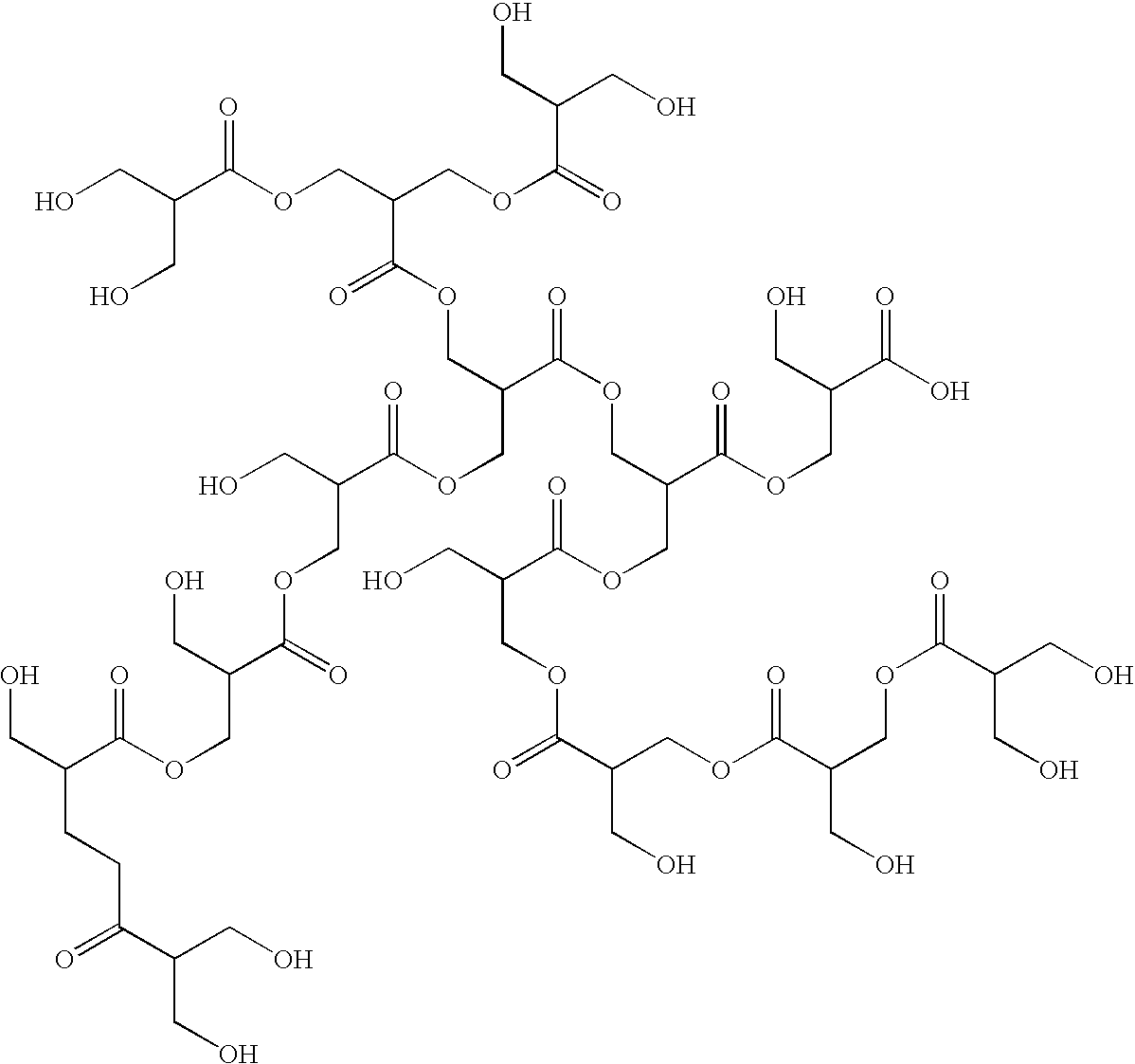Polymeric co-initiators
a technology of coinitiators and polymers, applied in the field of new polymeric coinitiators, can solve the problems of limited influence on viscosity, and achieve the effect of easy manufacture and easy compatibility
- Summary
- Abstract
- Description
- Claims
- Application Information
AI Technical Summary
Benefits of technology
Problems solved by technology
Method used
Image
Examples
example 1
[0191]This example illustrates the synthesis of a polymeric co-initiator with a hyperbranched polyglycidol core. The polymeric co-initiators CI-1 to CI-5 prepared, are represented by generalized formula CI-A.
Generalized Formula CI-A
[0192]
[0193]The hyperbranched polyglycidols selected for this example had three different molecular weights:[0194]PG8 : a hyperbranched polyglycidol with 8 hydroxyl groups on average;[0195]PG15: a hyperbranched polyglycidol with 15 hydroxyl groups on average; and[0196]PG36: a hyperbranched polyglycidol with 36 hydroxyl groups on average.
Synthesis of Polymeric Co-Initiator CI-1 (PG15DMBA4.1Piv10.9)
[0197]2 g of the hyperbranched polyglycidol PG15 was dissolved in 50 mL pyridine. The solution was flushed with nitrogen. 0.3 equivalents relative to the hydroxyl groups of 4-dimethylamino-benzoylchloride were added and the reaction mixture was heated to 100° C. for 16 hours. The reaction mixture was allowed to cool down to room temperature and 0.9 equivalents re...
example 2
[0207]This example illustrates the effectiveness of the polymeric co-initiators in radiation curable compositions.
[0208]The comparative radiation curable composition COMP-1 and the inventive radiation curable compositions INV-1 to INV-10 were prepared according to Table 6. The weight % (wt %) was based on the total weight of the radiation curable composition.
[0209]
TABLE 6wt % of:COMP1INV1INV2INV3INV4INV5INV6INV7INV8INV9INV10DPGDA4152524444505042424242Sartomer ™ SR3514130303030303030303030Irgacure ™ 5001010—10—10—10—10—Benzophenone——10—10—10—10—10Quantacure ™ EHA8——————————CI-1———1616——————CI-2———————1818——CI-3—88————————CI-4—————1010————CI-5—————————1818
[0210]The comparative radiation curable composition COMP-1 and the inventive radiation curable compositions INV-1 to INV-10 were coated on an unsubbed 100 μm PET substrate using a bar coater and a 10 μm wired bar. Each coated layer was cured using a Fusion DRSE-120 conveyer, equipped with a Fusion VPS / I600 lamp (D-bulb), which transp...
example 3
[0213]This example illustrates that the polymeric co-initiators according to the present invention are not likely to be extracted by food when food packaging materials are printed upon with a radiation curable ink containing such a polymeric co-initiator.
[0214]Radiation curable compositions were prepared according to Table 8 using the polymeric co-initiators synthesized in Example 1. The weight % (wt %) was based on the total weight of the radiation curable composition.
[0215]
TABLE 8wt % ofCOMP-2INV-11INV-12INV-13DPGDA53525042Sartomer ™ SR35130303030Benzophenone10101010Quantacure ™ EHA 7———CI-2——10—CI-3— 8——CI-4———18
[0216]The comparative radiation curable composition COMP-2 and the inventive radiation curable compositions INV-11 to INV-13 were coated on an unsubbed 100 μm PET substrate using a bar coater and a 10 μm wired bar. Each coated layer was cured using a Fusion DRSE-120 conveyer, equipped with a Fusion VPS / I600 lamp (D-bulb), which transported the samples under the UV lamp on...
PUM
| Property | Measurement | Unit |
|---|---|---|
| wavelength range | aaaaa | aaaaa |
| solubility | aaaaa | aaaaa |
| polydispersity | aaaaa | aaaaa |
Abstract
Description
Claims
Application Information
 Login to View More
Login to View More - R&D
- Intellectual Property
- Life Sciences
- Materials
- Tech Scout
- Unparalleled Data Quality
- Higher Quality Content
- 60% Fewer Hallucinations
Browse by: Latest US Patents, China's latest patents, Technical Efficacy Thesaurus, Application Domain, Technology Topic, Popular Technical Reports.
© 2025 PatSnap. All rights reserved.Legal|Privacy policy|Modern Slavery Act Transparency Statement|Sitemap|About US| Contact US: help@patsnap.com



